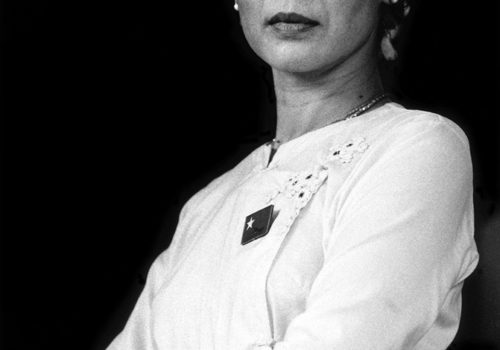Nic Dunlop – Kampong Cham, Cambodia, 1992
Nearly 40 years after the height of the Cambodian conflict, landmines continue to kill and maim civilians of all ages. This weapon of mass destruction in slow motion has led to thousands of amputees in northwestern Cambodia.
The Human Rights Center’s Eric Stover and British deminer, Rae McGrath, conducted the first research on the social and medical consequences of landmines in Cambodia. Their work helped to launch the International Campaign to Ban Landmines, which along with its director Jody Williams, won the Nobel Prize in 1997.
“When I began working in Cambodia in the early 1990s,” writes the Bangkok-based photographer Nic Dunlop, “I became obsessed with the problem of landmines and what they were doing to ordinary people. I took the pictures with a burning anger and desire to see these weapons outlawed.” Dunlop’s photographs helped galvanize public opposition to the production and distribution of landmines worldwide.
Susan Meiselas – Widow at Mass Grave, Koreme, Iraq, 1992
In the late 1980s, Saddam Hussein’s forces took control of Iraqi Kurdistan, killing thousands of Kurds and other minorities. Before entering the territory, the Iraqi air force dropped chemical weapons on scores of towns and villages. In this photo, a widow looks at the remains of family members found in a mass grave in the village of Koreme.
Following the first Gulf War, photographer Susan Meiselas accompanied a forensic team, led by Eric Stover and forensic anthropologist Clyde Snow, to Iraqi Kurdistan to investigate atrocities and exhume mass graves. Evidence collected during the trip was used in the trials of Saddam Hussein and Ali Hassan al-Majid, known as “Chemical Ali.”
“Working with a small group of Kurds, we excavated where the gravediggers remembered burying the dead,” writes Meiselas about the experience. “Meticulously, earth was shoveled and then brushed away by hand, until finally the skull of a male teenager appeared, bearing a cloth blindfold.” Meiselas was so moved by the trip, she later returned to Iraqi Kurdistan to research and publish Kurdistan: In the Shadow of History, a chronicle of Kurdish life told through a mosaic of portraits, diaries, and artifacts.
Mimi Chakarova – Cristina’s family photo, Moldova, 2004
Mimi Chakarova, a native of Bulgaria, spent 10 years investigating the world of sex trafficking in Europe and the Middle East to produce the documentary The Price of Sex. She says building relationships with the girls–even more than her skills as a photographer–was critical to telling their stories. In this photo, Cristina, a victim of sex trafficking at the age of 16, holds up an old family photograph.
“The young women I followed over seven years grew up in rural villages similar to my own,” writes Chakarova. “Under Communism, we secretly hungered for opportunities in the West and when the Berlin Wall fell in 1989, we left hoping for a taste of capitalism. Many young women, however, lacked the skills and education to survive. Desperate to leave, they fell prey to traffickers who sold them to pimps to work in brothels and sex clubs.”
Over time I tracked down several of these young women, and I chronicled their stories from the countries where they were trafficked and back again to their villages. This film is a testament to their courage and their willingness to expose the dark inner-workings of sexual slavery.
















